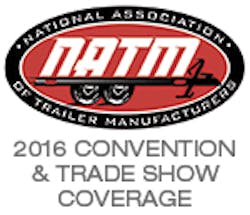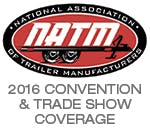GM wants to expand its partnership with trailering industry, with both sharing the responsibility of safety
TIMOTHY Herrick says General Motors reached the corner of Obligation and Opportunity, and it took the road to Opportunity.
“It’s a new part we see in the market,” said Herrick, GM’s executive chief engineer for Next Generation Full Size Truck. “
“We think the opportunity is how we can partner. We’re looking for partners to help between trucks and trailers. No longer should you see a truck as a necessary evil to drag your trailer around. We can have not truck plus trailer, but truck times trailer.”
In GM’s presentation, “Towing Trends,” Herrick said a truck customer isn’t always a trailer customer, but a trailer customer is always a truck customer.
“A lot of them buy the trailer first and then figure out what truck they need to haul it,” he said. “Truck companies share in the profit of trailer sales. You are a part of a huge industry. We want to help with that.
“Trailer companies share in the capability of truck technology. When we bring out new technology, it can make trailers more viable. Both industries share the responsibility of safety. Trailering safety should not be a leverage point against its competitors. We think you should share with all. General Motors invented the test dummy back in the 1960s. We didn’t hoard it so we could make our cars and trucks safer. We gave it to everybody. We think there are safety things we should all share.
“The safest experience will result from harmony between the automotive industry and the trailering industry. I can envision a day when they’re autonomous. Some might think it’s a joke, but there are some companies that are dead serious—Google and Apple—and so are we. I can see the day when a smart trailer and smart truck can drive autonomously and trailer together, but it can’t happen if the two aren’t talking to each other.”
Herrick said this is what we know about truck buyers in terms of their top product needs:
• Capability. Towing and payload are paramount.
• Engine performance and power (65% of retail buyers choose diesel engines).
• Aggressive, masculine styling.
• Roomy cab, comfortable ride, seat comfort.
“In terms of vehicle usage, they typically carry only one or two,” he said. “More than half who register as a personal vehicle also use the truck for business. They’re likely to use it for outdoor hobbies: hunting, fishing, camping. Off-road use is often related to business or work driving. We have to get some places you can’t get to with other vehicles. They use it for home projects and remodeling. Everybody goes to Home Depot. You can’t just spend $20 at Home Depot. It’s kind of like Costco. You come home with more than you need.”
Herrick said towing is the reason for choosing an HD pickup for those who pull 8000 or more pounds. Most commonly, they pull trailers (including fifth wheels) and campers.
Buyers would like improvements in:
• Fuel economy/range. “Everybody wants more for less. Even with decreased fuel prices, it’s one of the bigger things they’ll spend their money on.”
• Maneuverability/parking.
• Ride smoothness (rough roads). “I hear this every time I get into a truck with my wife.”
The US pickup market is forecast to be 2.2 million units, with light duty accounting for 1.6 million. Seventy percent of the light-duty buyers tow trailers, boats, campers, ATVs, and landscape equipment, and of those, 30% tow at least monthly.
The HD pickup market accounts for 600,000 units a year, with towing being the #1 reason for the purchase and 95% of the buyers towing. Campers, fifth wheel trailers, livestock, and construction equipment are most commonly towed.
How do customers approach trailering?
Herrick provided this comment from one buyer: “I got my (HD) truck because of the towing capacity. I was looking for an engine transmission combination, plus a long bed so that I can tow a fifth wheel. I don’t have to worry too much about having to limit myself … I haven’t gotten a big (trailer) yet… I want to get a fifth wheel within a year, and I don’t have any limitations as to what I want. It’s fifth wheel prepped … it’s ready to go.”
Said Herrick, “There are no substitutes: Heavy-duty pickup buyers do not cross-shop other segments. Heavy-duty pickup retail buyers stretch even more than their light-duty counterparts, spending an amount equal to half of their annual household income on a truck. It’s like, ‘I buy a chainsaw for the tree I might have to cut down some day.’ ”
Another customer comment: “When I’m trailering, I could be pulling a $65,000 boat or a $100,000 motor home. What I’m pulling behind me is very likely more valuable than the truck itself. I can’t screw it up.”
Herrick said there are opportunities for increased understanding:
• Sharing of research. “We’re looking at how we can marry the trailers and trucks together so that the whole is better than the individual pieces.”
• Improve product development.
• Focused marketing.
He said the industry focus has been on increasing the capability of the vehicle, but “that’s got to slow down and stop. Towing capacities are now higher than ever: up to three and a half times the truck weight. For the Silverado 3500HD, the curb weight is 6800 pounds and towing is 23,200 pounds.
“It’s time to think about functionality: make safety the overriding priority,” he said. “I think we’re a 6 o’clock newscast away from a young kid that’s going to load up a trailer. You see them and know who they are—and they’re going to put it behind a truck. This thing’s going to be maxed-up. The boss tells them, ‘I want you to get this thing crosstown now.’ So there’s this young kid with very little training, or zero training. There’s no legal requirement as to the stopping distance of that vehicle. How fast does it have to stop? I think one day somebody’s going to do something really bad and it’s going to hurt somebody. I’m here to say, ‘How can we make a smart trailer and I make a smart truck that when we put those two together, they’re better together’? Your trailer can try to save my truck and my truck can try to save your trailer for the overall betterment of everybody.”
• Integrated trailer brake controller. Allows your trailer’s brakes to operate simultaneously with the vehicle’s brakes.
• Auto grade braking. Works with the cruise control to maintain vehicle speed on long, steep grades.
• Exhaust brake system. Slows the vehicle and help reduce brake use. That means reduced brake fade, prolonged brake life, and more confidence when towing.
• Hill start assist. Holds the vehicle stationary on steep inclines (approximately one second), allowing the driver time to use the accelerator before the vehicle can roll backwards.
• Cruise grade braking. Downshifts to help slow the truck and preserve brake pads on long, steep descents.
Dynamics:
• Stabilitrak electronic stability control. Stabilitrak automatically intervenes when it senses loss of lateral traction.
• Automatic locking rear differential. Sends maximum drive power to the wheel with grip whenever rear-wheel slippage happens.
• Tow/haul mode. Adjusts the shift schedule in the automatic transmission so it isn’t “hunting” for the correct gear while towing or trailering
• Trailer sway control. Senses trailer sway and automatically applies the vehicle and trailer brakes and reduces engine power, if necessary to help you get back on track.
Visibility:
• Extendable trailering mirrors. Vertical manual-folding and extendable mirrors have 50 square inches of flat mirror surface and 20 square inches of convex mirror surface to help you see around you.
• Rear vision camera. Allows the driver to use the navigation radio screen (if equipped) or the rearview mirror to see certain obstacles located behind the vehicle when in reverse at low speeds.
• Hitching assist. Provide assistance to the process of initially aligning vehicle and trailer. Starting with visual aids and moving toward automated aligning of vehicle to trailer.
• See around the trailer. Increase visibility around a trailer in low-speed and high-speed driving to improve driver confidence. Moving toward a complete 360-degree camera and sensor coverage around trailer.
To make it smart:
• Trailer knowledge. Provide additional information to the driver on the status of the attached trailer, including full communication between trailer and vehicle.
• Trailer control. Allow the trailer to become part of common vehicle control features, such as anti-lock brakes and stability control.
• Trailer configuration. Store, use, and display information about the trailer to improve the experience through user friendly interactions.
To keep the customer safe and secure:
• Autonomy. Increase safety feature functionality while trailering. Moving towards autonomous driving capability to vehicles pulling a trailer.
• Security. Provide users with security and confidence while using their trailer.
Some emerging trailering technology:
• Pro backup assist. Semi-autonomous trailer backing. Driver indicates desired trailer path with a trailer steering knob. System controls vehicle steering to move trailer along intended path. Eliminates the need for counter steering.
• Remote trailer maneuver control. Maneuver vehicle and trailer from outside the vehicle using connected tablet. Smart steering for reversing and 360-degree camera view.
• Trailer camera systems. Camera mounted on truck enable unobscured visibility along sides of trailer. Auxiliary cameras attached to the trailer provide new views displayed on the vehicle’s integrated display. Camera hub mounted on trailer manages multiple inputs.
• Cargo view concept. Cameras mounted on the interior of the trailer allow for cargo monitoring. Combined with data services, such as OnStar, cargo can even be viewed remotely.
• “Invisible Trailer” concept. Vehicle cameras along with cameras attached to the trailer along with advanced algorithms to render a “through-view” of the trailer. Provides for confident highway driving.
• RV body control modules. Centralized control hub. Control lighting, pumps, generators, awnings, slides, jacks. Monitor water levels, fuel levels, battery status. Expandable sensor inputs and outputs. Smartphone connectivity.
Cohen said GM has maintained a high-profile presence in the trailer industry, with participation at the Recreational Vehicle Industry Association (RVIA) Trade Show, featuring the “Big 3” of RV Trailering: Thor, Forest River, and Jayco; by pursuing opportunities with emerging RV technologies; by working with NATM, becoming the first OEM to become an associate member and the first to attend and present at the NATM trade show (2016). GM is on nine trailer-specific committees and additional trailering-related committees.
Motions brought forward by GM to the Society of Automotive Engineers (SAE):
• All safety items should be declared publicly. Motion passed.
• Protect for digital camera execution. Motion rejected.
• Standardize CAN communication. Motion passed.
About the Author
Rick Weber
Associate Editor
Rick Weber has been an associate editor for Trailer/Body Builders since February 2000. A national award-winning sportswriter, he covered the Miami Dolphins for the Fort Myers News-Press following service with publications in California and Australia. He is a graduate of Penn State University.




